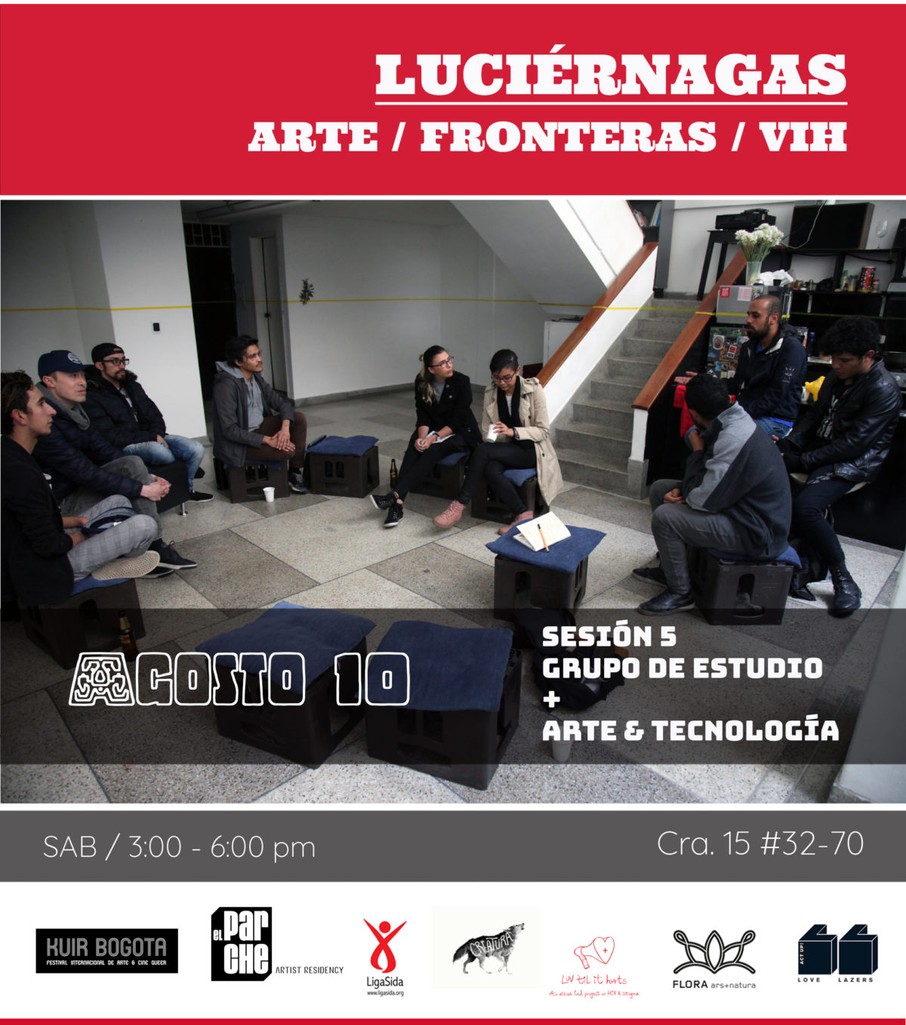Relatoría Sesión #5 – Arte & Tecnología (ES/EN)
by Daniel Santiago Salguero
Laboratorio Luciérnagas
Relatoría Agosto 10 – 2019
sesión #5
grupo de estudio
Invitada:
Constanza González
Relatoría:
Constanza fue directora de la Lida Colombiana de Lucha contra el Sida hace unos 15 años. Ahora trabaja para la fundación Keralty – Colsánitas en temas relacionados a redes de cuidado en un programa llamado Ciudades compasivas que opera en Bogotá, Ibagué, Manizales, Sta Marta, Cali, Medellín. La metodología es española. Constanza vinoacompañada de Ferney Camacho que trabaja también en el programa Ciudad Compasiva desde hace unos años.
Hablan de la importancia de trabajar desde lo artístico y lo humano. Tejer puentes, conexiones, redes. Hay fronteras de muchas clases. Hablamos sobre cómo la empatía nos ayudan a relacionarnos. Empatía quiere decir ponerse en el lugar del otro.
En el mundo de las conversaciones surge El Arte de conversar. El arte de tender puentes.
Hablaron del mito de Quirón, el mito del sanador herido. Lo relaciona con cómo conectarse con el dolor de los demás.
Compasión no es estar en la posición del salvador, pues en este rol no permite que cada uno se salve a si mismo. Es más un principio de humanidad compartida, entre iguales.
Pregunta: ¿la compasión funciona desde el sufrimiento?Abrir un espacio para el dolor del otro. En el dolor surgen sentimientos no necesariamente negativos. Culturalmente hemos asociado compasión con lástima, pero es diferente.
Paul Gilbert (psicólogo) dijo en 2015 que la compasión surge de la profunda conciencia del sufrimiento de uno mismo y de otros seres, junto con el deseo de ayudar a evitarlo.
Hace unos años se descubrieron las neuronas espejo. Se activan y reflejan la historia del otro en nosotros y despiertan y detonan dolores.
La compasión no es relación entre sanador y herido. Es una relación entre iguales.
Pema Chödrön, monja budista estadounidense recomiendan libro: Los lugares que te asustan, – cuando todo se derrumba.
Desde la neurociencia y la psicología revisan conceptos cómo: Cultivo de compasión. Interdependencia: dependemos de todos
Creemos que desconociendo nuestros miedos vivimos mas felices. Si no los enfrentamos no los resolvemos.
El concepto de compasión con uno mismo. Estar abierto al dolor del otro y al propio.
Hay tipos de medicinas donde los doctores se entrenan en la compasión.
Ser compasivo es ser firme, no es ser pendejo.
No es por ser políticamente correcto, es diametralmente opuesto.
En la medida que adquirimos conciencia adquirimos responsabilidad.
____________________________________________
EN
Luciérnagas Lab
August 10 – 2019 Report
session #5
study group
Invitee:
Constanza González
Report:
Constanza was the director of the Liga Colombiana De Lucha Contra el Sida (Colombian Alliance for the Fight Against Aids) about 15 years ago. She now works for the Keralty – Colsánitas foundation on themes related to networks of care, in a program called Ciudades Compasivas that operates in Bogotá, Ibagué, Manizales, Star Marta, Cali, Medellín. The methodology is Spanish. Constanza came in the company of Ferney Camacho, who has also been working in the program Ciudad Compasiva for a few years.
They speak of the importance of a work that departs from the artistic and the human. To knit bridges, connections, networks. There are many kinds of borders. We spoke of how empathy helps us relate to one another. Empathy means to put oneself in the place of another.
In the world of conversation rises The Art of conversing. And the art of building bridges.
They spoke of the myth of Chiron, the myth of the wounded healer. They relate it to how one can connect with others’ pain.
Compassion does not mean to be in the position of a savior, as that role does not allow for each individual to save him/herself. It is more a principle of shared humanity, among equals.
Question: Does compassion work out of suffering?
To open up a space for the pain of the other. Certain feelings arise during pain that are not necessarily negative.
Paul Gilbert (psychologist) said in 2015 that compassion arrises from the profound awareness of one’s suffering as well as that of others, along with the desire to help avoid it.
Some years ago, mirror neurons were discovered. They activate and reflect the others’ history in ourselves, awakening certain pains.
Compassion is not a relationship between the healer and the wounded. It is a relationship among equals.
Pema Chödrön, a Buddhist monk from the United States, recommends the following book: The Places That Scare You.
Terms from neuroscience and psychology are reviewed, such as: the cultivation of compassion. Interdependence: we depend on everyone.
We believe that by not knowing our fears we can live happier. If we do not face them we do not solve them.
The concept of compassion with oneself. To be open to the pain of the other and of ourselves.
There are types of medicinal training in which doctors are trained in compassion.
To be compassionate is to be firm, not to be an idiot.
It is not about being politically correct, it is diametrically the opposite.
At the measure in which we acquire consciousness, we acquire responsibility.

